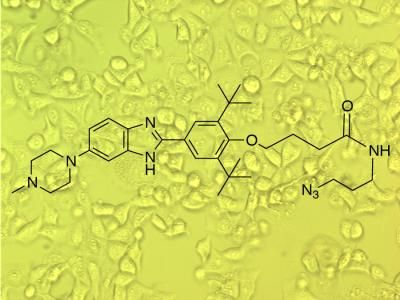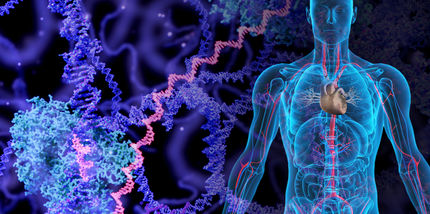New drug candidates from genome sequence
As proof-of-principle, the team designs potent anti-cancer compound
In research that could ultimately lead to many new medicines, scientists from the Florida campus of The Scripps Research Institute (TSRI) have developed a potentially general approach to design drugs from genome sequence. As a proof of principle, they identified a highly potent compound that causes cancer cells to attack themselves and die.

The new method identified a highly potent compound that causes cancer cells to attack themselves and die.
Disney lab, The Scripps Research Institute
"This is the first time therapeutic small molecules have been rationally designed from only an RNA sequence—something many doubted could be done," said Matthew Disney, PhD, an associate professor at TSRI who led the study. "In this case, we have shown that that approach allows for specific and unprecedented targeting of an RNA that causes cancer."
The technique, described in the journal Nature Chemical Biology online ahead of print, was dubbed Inforna.
"With our program, we can identify compounds with high specificity," said Sai Pradeep Velagapudi, the first author of the study and a graduate student working in the Disney lab. "In the future, we hope we can design drug candidates for other cancers or for any pathological RNA."
In search of new approaches
In their research program, Disney and his team has been developing approaches to understand the binding of drugs to RNA folds. In particular, the lab is interested in manipulating microRNAs.
Discovered only in the 1990s, microRNAs are short molecules that work within virtually all animal and plant cells. Typically each one functions as a "dimmer switch" for one or more genes; it binds to the transcripts of those genes and effectively keeps them from being translated into proteins. In this way microRNAs can regulate a wide variety of cellular processes.
Some microRNAs have been associated with diseases. MiR-96 microRNA, for example, is thought to promote cancer by discouraging a process called apoptosis or programmed cell death that can rid the body of cells that begin to grow out of control.
As part of its long-term program, the Disney lab developed computational approaches that can mine information against such genome sequences and all cellular RNAs with the goal of identifying drugs that target such disease-associated RNAs while leaving others unaffected.
"In recent years we've seen an explosion of information about the many roles of RNA in biology and medicine," said Peter Preusch, PhD, of the National Institute of Health's National Institute of General Medical Sciences, which partially funded the research. "This new work is another example of how Dr. Disney is pioneering the use of small molecules to manipulate disease-causing RNAs, which have been underexplored as potential drug targets."
'Unprecedented' findings
In the new study, Disney and colleagues describe their computational technique, which identifies optimal drug targets by mining a database of drug-RNA sequence ("motif") interactions against thousands of cellular RNA sequences.
Using Inforna, the team identified compounds that can target microRNA-96, as well as additional compounds that target nearly two dozen other disease-associated microRNAs.
The researchers showed that the drug candidate that inhibited microRNA-96 inhibited cancer cell growth. Importantly, they also showed that cells without functioning microRNA-96 were unaffected by the drug.
"This illustrates an unparalleled selectivity for the compound," Disney noted. "In contrast, typical cancer therapeutics target cells indiscriminately, often leading to side effects that can make these drugs difficult for patients to tolerate."
Disney added that the new drug candidate, which is easy to produce and cell permeable, targets microRNA-96 far more specifically than the state-of-the-art method to target RNA (using oligonucleotides) currently in use. "That's unprecedented and provides great excitement for future developments."























































